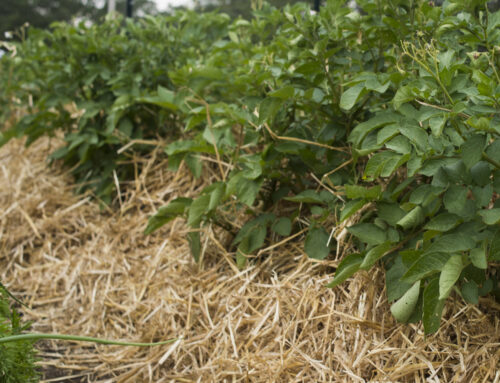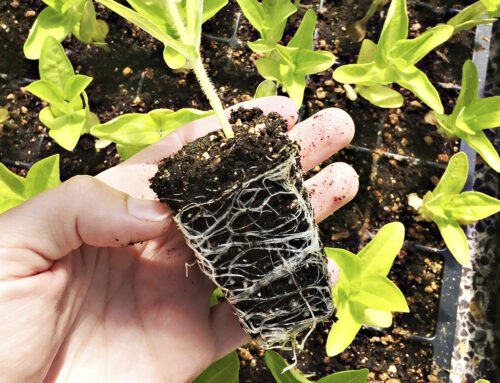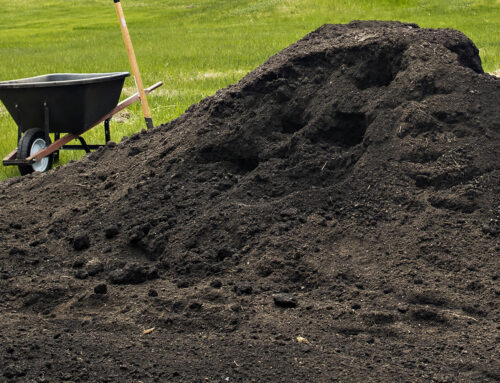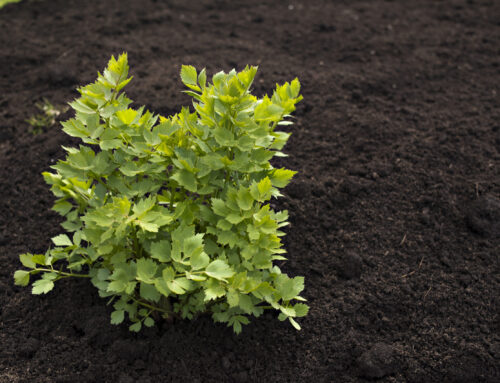Some people call them garden mistakes, but I prefer to think of them as opportunities—or even garden experiments. Gardening is a learning process, and to help you avoid heartache, I’m going to share with you the most ten most common garden mistakes, and how you can escape them!

As every gardener before me, I’ve made a lot of my own mistakes! I don’t even think I’m done, because I’m always learning in the garden. My garden is constantly evolving, I’m trying new things and sometimes I’ll get it right, and other times I’ll need to do something different.
Throughout my years working at garden centers, nurseries, farming, volunteering and just shooting the breeze with fellow gardeners I’ve heard it all. However there are some perpetual “mistakes” that continue to come up. So I’m going to share with you the most common gardening mistakes in hopes of you avoiding them.
#10 Forgetting Fencing
Oh my word. If you live in any sort of wildlife-friendly location or have seen deer nearby, garden fencing will mandatory. I cannot tell you how many heartbreaking stories I’ve heard from people who sow, grow and nurture their amazing little plants, only to have then eaten by deer or other nibbling critters. Protection is key!
Gardens with deer problems will require 7’ fencing to keep them from jumping into and eating away your garden. In smaller, or narrower gardens, you could get away with shorter 3-4’ fencing, since deer have undeveloped depth perception. If they can’t “see” adequate space to land, they will not jump in.

Invisible polypropylene fencing is a great option since it’s almost invisible, and won’t impede the “view”. Deer are uncertain if they can jump a fence when they don’t have a clear sense of where the top is.
And even if deer aren’t your number one frenemy, other gnawing creatures can create problems. I am personally dealing with a groundhog family that lives under our garden shed as well as a field mouse population that think my peas are planted just for their pleasure. Smaller “fencing” is the answer here. Row covers and chickenwire are cheap, simple solutions that will exclude these little beasts that want to strip your garden of all its fruit and flowers.
#9 Underestimating full-grown size
Plant spacing is one of those concepts that still mystifies new—and experienced—gardeners. Seed packed and plant labels will always instruct you on how far apart to space your young plants. Following these instructions allows for ideal air circulation, form and development.
It is incredibly tempting when you purchase young plants or perennials, to place them super close to get that lush garden look you see in magazines. However this path will lead you astray.
When my husband and I moved into our current home, I planned a large bed of Russian sage on the side of our house. Yes, one of my main goals was to hide the big old generator, but I also wanted it to look pretty. After coming home with my 1-gallon pots of Russian sage to say my husband was underwhelmed is an understatement. The plants were so small and they certainly didn’t camouflage anything at that point. But I promised him that if he was patient, and waited it would all turn out okay. And it did! After one season the plants were more than double their original size, and by their second year, it was one large sublime cloud of pale lavender. And no big generator-eyesore in sight!

Have faith. Your plants will grow. Trust the spacing and be patient. The reward is worth waiting for.
Kitchen gardens, or vegetable gardens can handle slightly more intense plant spacing when you know you’ll be harvesting regularly. I have a whole entire post dedicated to Intensive Plant Spacing and Sowing (check it out HERE),
#8 Postponing Weeding
I am guilty of this one. I want to find weeding cathartic and satisfying, but … I don’t. However stronger wills must prevail.
Weeding can get out of hand very quickly if you aren’t on top of it. My system is to weed regularly. As long as I weed a little and often, nothing gets out of hand.
Good garden hygiene and organic methods can also contribute to keeping weed pressure to a minimum. Staying on top of weeding is essential. When weeds are picked before they flower or go to seed—which is how they spread and multiply—they should only be minor inconvenience.

Garden needing weeding. DESPERATELY!
Personally I’m an epic fan of practicing no-dig in my garden (for more details on No-Dig Gardening, click HERE). This keeps my garden almost weed free. Annual digging in actually pulls more weed seed up into your soil, creating more of a problem.
#7 Giving up too soon
Don’t throw in your trowel too soon. Gardening is a journey. This is what every newbie—and experienced—gardener should remember. Sometimes things will grow exactly as planned, and other times that new variety or bed design may not be as brilliant as you imagined. And that’s okay!
When you look at other people’s gardens do not for one minute think that it was a smooth path to that stellar garden. Everyone learns. It takes time. I understand and remember more about not to do after I’ve made a mistake and how to get it right, than when things go exactly perfectly.
Ten years ago I had this incredible vision for how I was going to camouflage my deer fencing. Yes, I’m talking about that same polypropylene fencing I just mentioned earlier. We have lots of deer. My solution was hops. I was going to grow this gorgeous vine—with so many uses—around my kitchen garden on my deer fencing. Metal t-posts were in every 4-6’ feet and I thought that would be strong enough. Fast forward to August when in between every t-post the plastic fencing was drooping under there weight of the hop vine. Consider it a lesson learned. I still grow hops … just on a much stronger trellising system!

So, when things go wrong, don’t give up. Take a deep breath, and just do it differently next year.
#6 Not harvesting regularly
Harvesting is such a biggie. It is way too easy to be a neglectful gardener in the swell of the summer when the garden is pumping. Whether you’re coming home after work to a hot, humid day or you just spent the day wrangling your little one’s at the park or beach and don’t have it in you to traipse out to the garden, do it!

The garden is a quiet place. I imagine you’ll find it more relaxing that you thought. Plus, you won’t be overwhelmed by the days harvest if you stay on top of it. Try to get out there every 3-4 days to harvest your peas, tomatoes, cucumbers, dahlias or whatever you’ve got growing. For many plants, the more you pick, the more you get. Each time you harvest, you’re creating more airspace for healthy growth, and more importantly, making sure your plants know the season isn’t over. Vegetables and fruit can rot or pass their most tasty or palatable stage when left on unharvested too long. While flowering plants will start their seed production when their blooms are left on the plant.
Grab a basket and a bucket, and take some time to reconvene with nature. Not only will you have yummy things to include with dinner or decorate your kitchen table, taking time to enjoy the calm and stillness is restorative.
#5 Seeding or planting too early
Raise your hand if you’ve ever planted your tomatoes too early. Every gardener has done this at least once—and not just with their tomatoes.
When seed packets being arriving, it is exceedingly tantalizing to start sowing. The primary issue with starting seeds too early is, the seedlings will be larger than it should be when it’s time to plant in the garden. Smaller seedlings will acclimate better—and often will surpass in both size and vigor, plants which are older and larger. Bigger seedlings take much longer to root, set flowers and fruit. Waiting until the appropriate time to start your seedlings will ensure you have a thriving, productive garden all season long.

If you’re unsure of when to seed, download my FREE Sowing Schedule HERE! I’ve broken which vegetables, herbs and flowers need to be sown when according to your last frost date. For more details on a sowing schedule and plant spacing, check out the post HERE.
#4 Overwatering
Watering s the number one cause of most plant deaths. Plants can sometimes die from be under-watered. However, more often that not, it is overwatering that kills your plants.
Your watering mantra should be: Water deeply and infrequently.
It is tempting to go out to water every other day to make sure your plants have ample water. Short, regular watering periods results in only the soil surface getting wet, which evaporation then sucks away from the plant. This type of superficial watering doesn’t get deep enough to hit the root zone, which is where the plants need it.

Alternatively, giving seedlings and plants a deep watering every other day will result in root rot. When the roots become too wet—plant roots need air as well as water—and they cant breathe. Essentially it’s like you’re smothering you plant with a pillow by overwatering.
Root Rot
Early signs of root rot include stunted, wilting or discolored leaves. When leaves and shoots die back this is a more obvious warning that your plant is about to die from root rot. Young seedlings’ are particularly vulnerable. Take a peek at the roots, pop them out of their tray or pot by gently pulling on the stems closest to the soil. Healthy seedlings and plants have white, firm roots, whereas those with root rot will have soft, squishy, brown roots. Potting soils with mycorrhizae (more of that wonderful symbiotic fungus HERE) lessens your chance of root rot, as the mycorrhizal fungi feed on the fungi that cause damping off. Bringing this full circle, the easiest way to avoid root rot is to avoid overwatering. Water once a week, watering more only if the soil is dry.
Key to Watering the Garden
Most plants need only one inch of water a week to produce and thrive. You’d think that isn’t enough, but you’d be wrong. In temperate conditions (not too hot, not too cold) I water for 20-30 minutes once a week.

When the heat starts cranking up mid-summer, I being watering deeply (20-30 minutes) twice or three times a week to prevent dehydration. If you’re not sure whether your garden needs more water, observe your plants. Do they look limp? Are the leaves less shiny? Colors more muted? If so, YES! Then start watering more, keeping in mind to water deeply.
#3 Your garden eyes are bigger than your stomachs
Start small. It’s easy to get taken in by all the spawning, elaborate gardens on instagrams. Keep it real and manageable. Gardening is one of the most fulfilling hobbies, you don’t want it to feel paralyzing. Which can happen when you plant too many vegetables, herbs and flowers.

I get it, you want to grow all the things. So do I! However, it’s much better to enlarger your growing space each year, then giving it a go all in one. Expanding slowly over time gives you the time to learn what you like to grow, what grows well where, and what you might want to do differently the following year. Because that happens. One season you have this incredible idea for a garden layout, then realize the flow or functionally really isn’t working. Growing slowly is vital to avoiding costly mistakes and losing your garden mojo.
#2 Location, location, location
Chant quietly to yourself; “Right plant, right place!” Placing your plants the correct garden location is imperative to their survival. When the growing conditions are ideal your plants won’t need much from you to thrive and produce heavily.
Think climate. Make sure you are growing plants that are suitable for your growing zone. The USDA has an interactive climate map HERE. Mine is 5b. Which means that stunning bougainvillea vine I saw everywhere on vacation in Key West is not going to be growing in my cold climate garden. But bring on the peonies, baptisia and echinacea!

Sunlight is vital. Unfortunately most vegetables, herbs and flowers are going to require full sun. Six or more hours a day are mandatory for these sun-loving plants, with more light always being better. Part shade locations usually involve garden spaces that part of the day are shaded by trees or existing structures, and half the day not. Shade means exactly that, little to no direct sun. Trying to grow sun-loving, warm crops like tomatoes or cucumbers in part to fun shade is going to be a mistake with very little produce, and more than likely some disease.
Plant your seedlings and young plants where they’ll be happiest and you cant go wrong.
#1 Skimping on your soil
Dirt may not seem flashy, but you’d be surprised at how exciting your soil—and those things that live within it—really are. Soil is the number one place you should be spending your money and time on in the garden.
If there was ONE piece of advice I was going to give a new gardener, it would be: take care of, and improve your soil.
Healthy soil harbors all sorts of microgorganisms, good fungi and bacteria that keep your garden robust. Earthworms—who I like to call Mother Nature’s tiller—and mycorrhizal fungi are just a couple of the things that will make your garden vigorous and prosperous.

Each and every year I top off all my garden beds with a generous supply of compost. Compost feeds all those soil microbes that enrich your soil with nutrients and feed your plants. My favorite compost is a Surf and Turf blend from Benson’s Farm. The addition of marine life to the compost brings many benefits to the garden, not the least is micronutrients and growth hormones which your plants will love!
Check out some of my earlier posts for a deep dive into Soil and Mycorrhizal fungi in for more information.
Bonus — I gotta mention Mulch!
Yes, I have yet again exceeded my numbered list. But I just have to mention mulch. New and even more experienced gardeners forget this bad boy. Mulch does so much including keeping your plants free of soil-borne disease, roots cool and the ground moist.

Overlooking mulch will create more work on your part. You’ll need to water more, check for disease often, and be weeding all the time. So make sure to spread a couple inches of straw, seaweed or your favorite mulch around your plants for a happy garden.
When I was working at the plant nursery, these were the problems I most often encountered. I hope that making note of these mistakes, you’ll be able to avoid them entirely and just garden!




